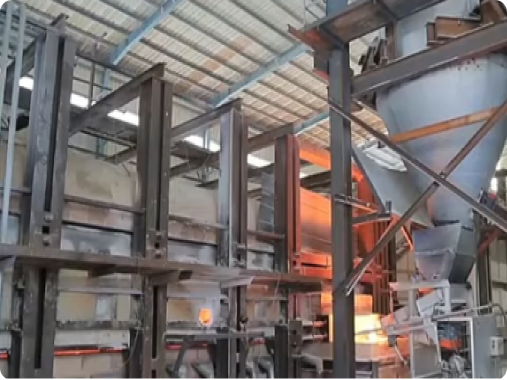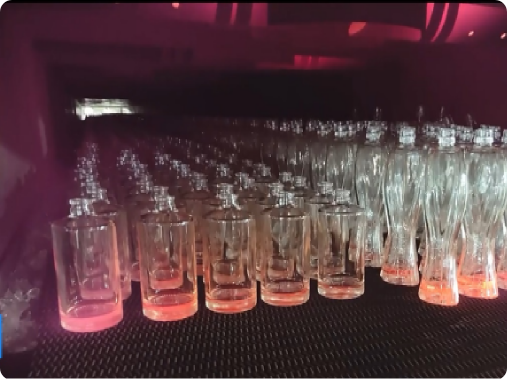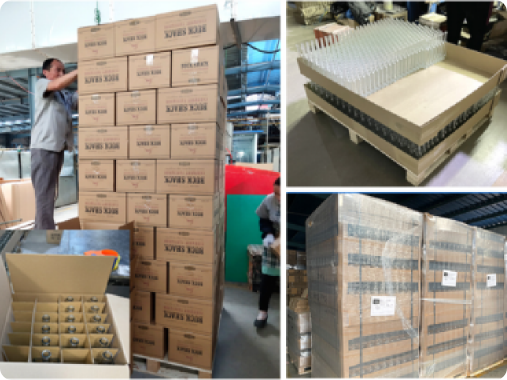
1.Choosing the raw material
The glass bottles are generally made of 7 to 12 different2. materials, and the primary materials used in the glass bottle manufacturing process are silica sand, sodium carbonate, limestone, dolomite, feldspar, borax, barium, and so on.
The most important raw material is silica as it determines the strength of the glass. The amount of silica can be chosen based on the type of glass to be made. The silica content is important as the melting point of the glass is inversely proportional to it.

2.Batch house
The manufacturing of the glass is a continuous process, so the batching processes will also occur continuously. Here the raw materials will be weighed and mixed, and then transferred into the hopper which is at the melting furnace.
Initially, the raw materials are feed to the hopers where it will get mixed and then transferred it into the furnace. Sometimes the conveyor belt consists of a magnet that will remove the magnetic materials. Once the raw material is mixed well, then it is feed into the furnace continuously using the batch process so that the composition of the material will be the same for all the processes.

3.Melting
In the melting process, the batched materials will be fed into the furnace, and in the furnace, the raw materials will get heated and melted. The batch materials are heated at high temperatures and the average temperature is 15500 degrees to 16000 degrees. In the furnace, the raw material will form a liquid glass and it should be uniform, free of bubbles, and also that should come under the molding requirements. The melting temperature entirely depends on the composition.

4.Feeding
The next process is the feeding process, and in this stage, the glassblowers will be feed. The feeding of the glass gob should be done at an optimum temperature. The temperature is chosen based on the weight and shape of the bottle. Then the glass is fed into the glass-bottle forming machine through the feeder.
The feeders will have an opening at the end, and low shear panels control this opening. The speed of the sheer mass can be controlled and if you need a big size glass then the sheer speed should be less.

5.Forming
Once the elongated shape has been cut from the furnace, then the next step is to get the shape of the bottle. In the forming process, the forming machine will transfer the garbs into the container. Once the garbs are placed inside the mold, now air is blown into the forming machine, so that the shape will be obtained.
Once the shape is formed, it is removed from the mold. If you need to join any other shape to the glass, then you need to do it at this step, or else the glass will become hard, and then you need to melt the glass again.

6.Annealing
Once the glass is removed from the glass forming machine, then the next step is annealing. The annealing process is required, as it will remove the stress, phase separation, or crystallization inside the glass. During this stage, the structural state of the glass will get changed.
The stress is caused mainly as the outer surface of the glass gets cooled rapidly than the interior side. The annealing process will help to cool both the inside and outside of the glass evenly to avoid any stress in the glass. This will also help to prevent the crack in the glass, and make the bottle stronger.

7.Inspection
Inspection is the most important step as it will help to find out the quality of the glass. Only the glass bottle which has been passed the inspection will be taken for the next level, and others that didn’t pass the inspection will be carried to the glass manufacturing process called cullet. The inspection is done at various levels, and in some cases,
both manual and automatic inspection will be done to ensure a high-quality product to the customers. During the inspection, the size, shape, and defects will be checked, and the most common defects will be cracks, pinholes, contamination, and air trapped inside the bottles.

8.Additional Method
The glass bottle manufacturing process involves three additional methods, that includes;
·Decal
Decal is a process that is used to create fine lines in the design of the glass, and also it will offer an attractive finish and higher durability. Once the design has been made, then the glass will undergo a drying and firing process.
·Frosting
Frosting will produce a high-quality glass, and the frosting can be done by sandblasting or and etching. The frosting can be done any kind of glass, and while working with acid you need to be careful. color spraying

9.Packing and Shipment
Based on the customer’s requirement, the bottle will be packed accordingly. Also, the bottles are packed according to the destination, and then they will be stored in the warehouse or will get shipped to the customers.
The glass bottles will be wrapped in a cardboard box, and this box will contain multiple segments that have been separated by corrugated sheets. Mostly, the packaging will be an automatic process, so that any kind of damage can be avoided.


